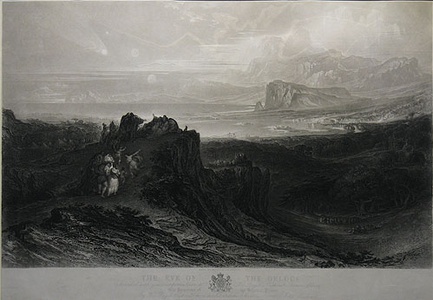| Method | Mezzotint with etching |
| Artist | John Martin |
| Published | Printed by S. H. Hawkins London, Published Jany.!.1844, by Thomas Boys, Printseller to the Royal Family, XI Golden Square, Regent Street. |
| Dimensions | Image 392 x 650 mm, Plate 478 x 735 mm |
| Notes |
Martin's The Eve of the Deluge is based upon his oil painting of 1840 and features the ancient, expiring Methuselah and the family of Noah on a rocky promontory. They overlook a mountainous landscape on the night preceding the Great Flood. The contiguity of the sun, moon and comet in the sky above, foretells the arrival of the catastrophic flood sent by God. The print has a clear sense of foreboding to it as antediluvian revellers continue their dancing in the middle distance, oblivious of the devastation to come. The composition of The Eve of the Deluge had been worked out in 1833 as an illustration for the first part of John Galt's The Ouranoulogos, Or, The Celestial Volume. John Martin (1789-1854) was an English painter, illustrator and mezzotint engraver. He achieved huge popular acclaim with his historical landscape paintings which featured melodramatic scenes of apocalyptic events taken from the Bible and other mythological sources. Influenced by the work of J.M.W. Turner (1775-1851) as well as Theodore Gericault (1791–1824), Eugene Delacroix (1798–1863) and Paul Delaroche (1797–1856), his paintings are characterised by dramatic lighting and vast architectural settings. Most of his pictures were reproduced in the form of engravings, and book engravings, from which he derived his fortune. Despite his popularity, Martin's work was spurned by the critics, notably John Ruskin, and he was not elected to the Royal Academy. His fame declined rapidly after his death, although three of his best known works of religious art toured Britain and America in the 1870s: The Great Day of his Wrath (1853, Tate, London), The Last Judgment (1853, Tate) and The Plains of Heaven (1851-3, Tate). A great contributor to English landscape painting, Martin was a key influence on Thomas Cole (1801-48), one of the founding members of the Hudson River School. CW 135; Campbell, Visionary Printmaker, p. 182. Condition: Crease to sky in image. Light vertical crease to right hand side of image. Small tears to the extremities of the sheet one just affecting right hand side of image. |
| Framing | mounted |
| Price | £875.00 |
| Stock ID | 28743 |

